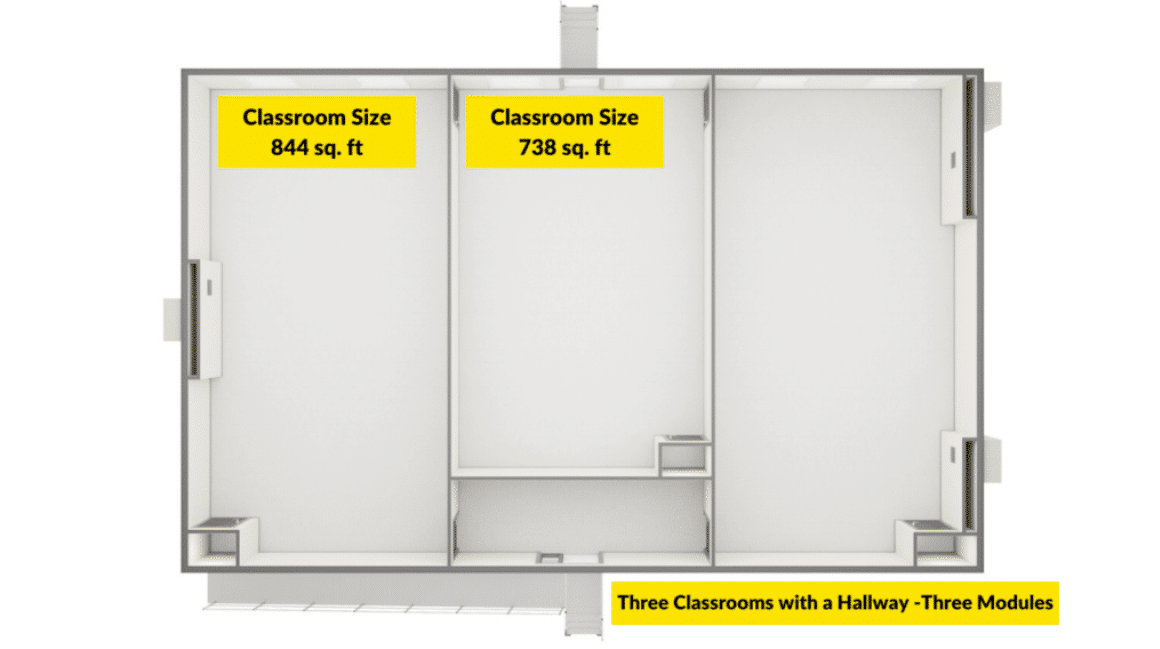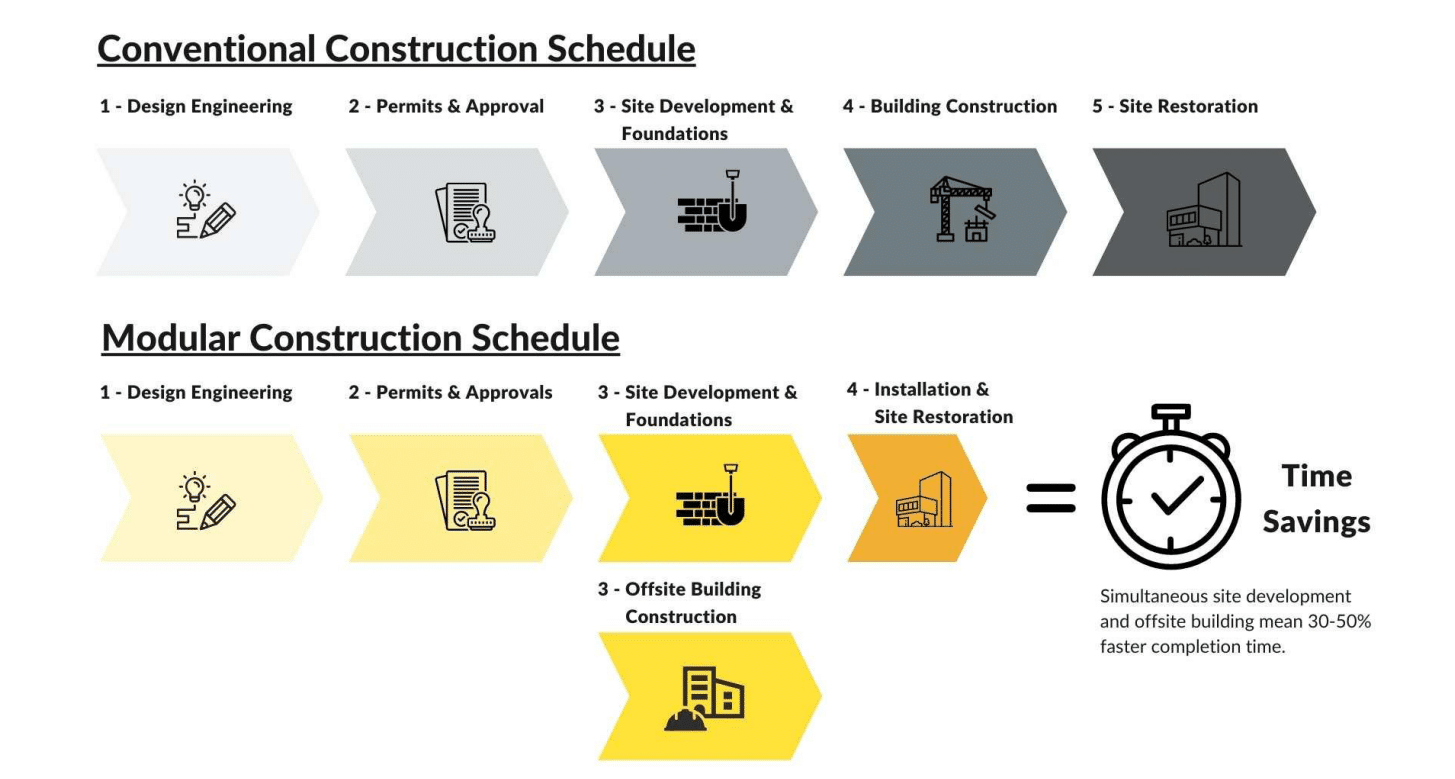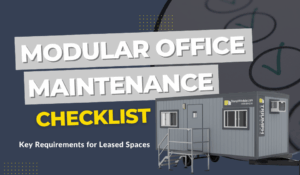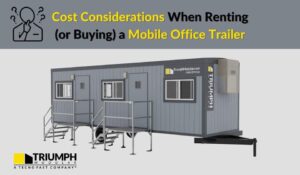Modular classroom construction offer a wide variety of solutions to school administrators.
Modular classrooms offer school administrators a flexible, cost-effective solution to accommodate growing student populations without the delays and expenses of traditional construction. These pre-fabricated buildings can be quickly installed, helping schools respond to enrollment changes or temporary space needs with minimal disruption. Additionally, modular classrooms are built to meet the same codes and standards as permanent structures, ensuring a safe, high-quality learning environment while supporting budgetary and scheduling efficiency.
What is a Modular Classroom?
Modular classrooms are prefabricated buildings that are constructed off-site to be used as classroom buildings for schools or other educational institutions.
Depending on a school’s needs, modular classrooms can come in many different size configurations.
For example, a simple project could consist of just one stand-alone module. In New England, standard sizing would mean that the module would measure 14 feet wide and be either 66 or 70 feet long.
Another larger and more complex configuration could combine three of these modules together to create three classrooms and a hallway—like this example from Triumph Modular:

A three-classroom configuration complete with a hallway created by combining three standard modules together.
Standard configurations are readily available when considering leasing modular classrooms, while custom configurations can extend the timeline and are better suited for a purchase. Modular classrooms can also integrate with existing school buildings or be a standalone solution with connections to utilities—it all depends on your needs.
What Are the Benefits of Modular Classrooms?
When starting a new classroom project and assessing your options, you might ask yourself:
“Why modular classrooms over traditional construction?”
Both options can work for a project. It all depends on your needs.
However, modular classrooms do offer a bevy of benefits over their traditionally built counterparts.
Here are a few of those.
1. Speed to Occupancy
The number one benefit that comes up anytime we talk about modular classrooms is speed to occupancy.
The modular process cuts down on build time significantly. By constructing the building off-site, contractors can begin the on-site preparation with foundations and other site work at the same time.
These two processes happening simultaneously can cut down construction time by 30-50%!

2. Lower Site Impact
Although it’s best for construction to begin during the summer months when students are on vacation, this scenario isn’t always possible. Sometimes, schools require a building during the school year.
With traditional construction methods, additions and new buildings can lead to significant disruptions to a learning environment. It’s hard for students to learn with loads of heavy machinery, power tools, and other construction-related distractions.
Modular classrooms are instead built off-site in a factory setting and delivered to the site as completed modules with far less impact. There’s still on-site work, but it will be far less disruptive than building the entire project on-site.
3. Reduced Waste
Sustainability and environmental impact in construction continue to grow in importance. Schools want to know that their building choices are leaving little impact on the environment.
Modular contributes to eco-friendly construction practices in several ways.
For starters, a controlled factory environment means less waste—materials won’t be damaged by the elements, and unused pieces can be recycled or reused in future builds.
Also, since most of the build takes place off-site, there’s less time where large machinery is on-site and pushing carbon emissions into the air.
4. Cost Predictability
Schools have tight budgets that need to be met despite needing new buildings or space.
Modular classrooms aren’t always the least expensive option. However, what they do offer is cost predictability. As long as design changes are kept to a minimum, costs remain stable, and the quotes provided at the start of the project are accurate.
Compare this to traditional construction: Without a standardized building practice and the controlled environment provided by modular construction, there are many things that can go wrong and move the goalpost. Costs can begin to climb due to the nature of traditional construction.
Temporary or Permanent Modular Classrooms: Which One is Right For You?
Beyond sizing configurations and other customizable features, there are also two primary types of modular classrooms: temporary and permanent.
So, which one is the right option for your project?
In general, temporary modular classrooms are, as the name suggests, the right fit for shorter-term projects. For example, disaster relief projects that require temporary space or additional space during renovations. Short-term usage can vary—many schools use temporary classrooms for two to three school years.
On the other hand, permanent modular classrooms are for longer-term projects and for situations where the classrooms are purchased instead of leased.
How Much Do Modular Classrooms Cost?
Modular classroom costs are affected by various factors, including:
- Whether it’s temporary or permanent
- Size
- Site work
- Setup and integration with existing school systems
- The complexity of the build
What you pay for each of these factors will depend on the modular company. For example, at Triumph Modular, we price our buildings based mostly on square footage. For leased buildings, you can expect a base of around $275 to $300 per square foot. Meanwhile, for purchased buildings, expect a base anywhere between $475 to $525 per square foot. The price-per-square-foot range includes the cost of the classroom (rent or purchase), delivery, installation, site prep, and site work. It’s around a 60/40 split for the cost of the space versus the other costs.
Learn More About Modular Classrooms In Our New Guide
Need more information about modular classrooms?
Our latest ebook, The Guide to Modular Classrooms, goes in-depth on the specifics you need to know for your next project, including costs, permits, and much more.
Download our guide today!




